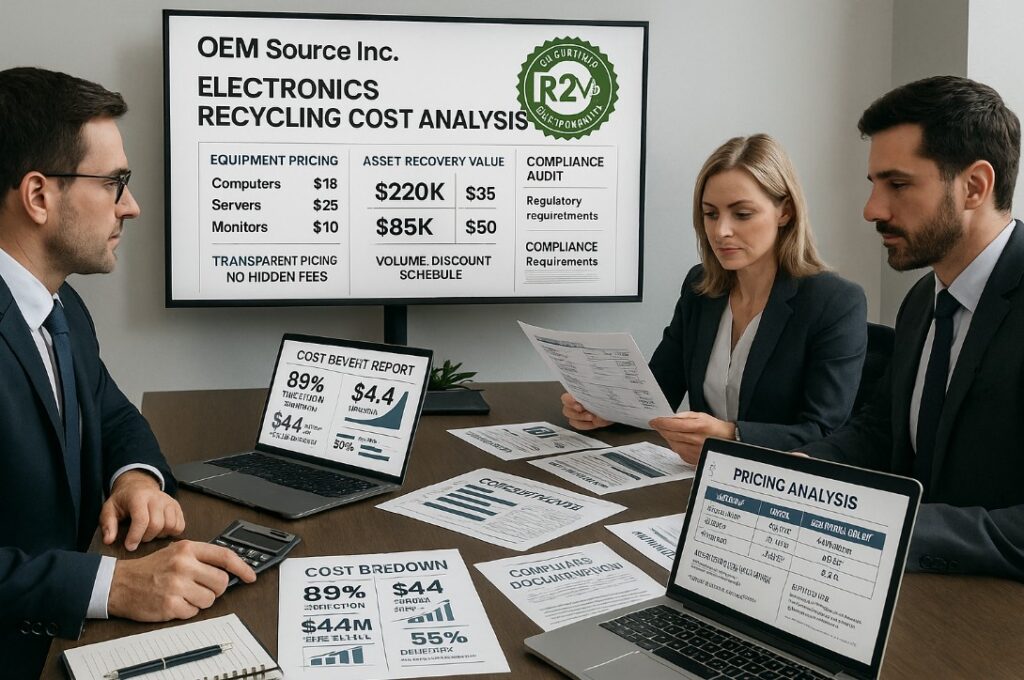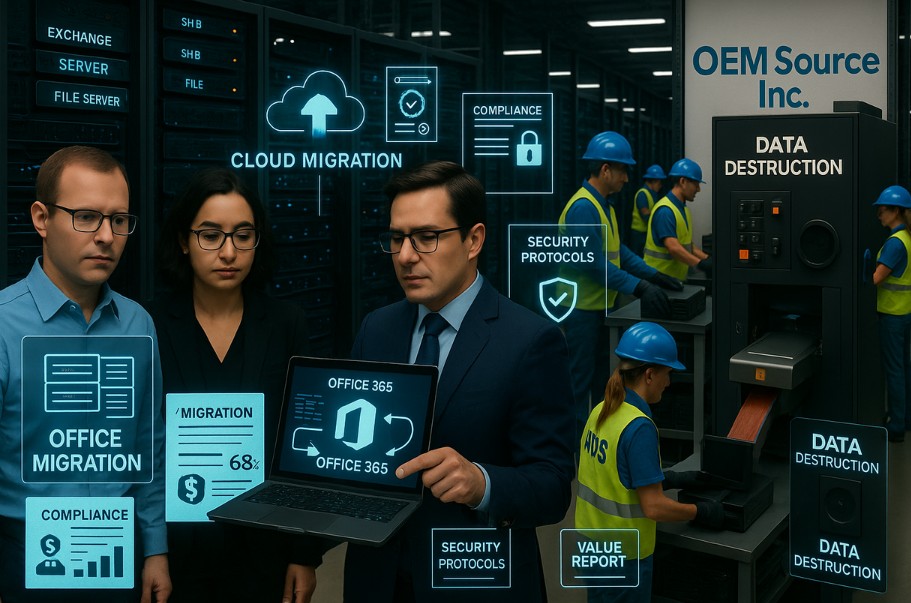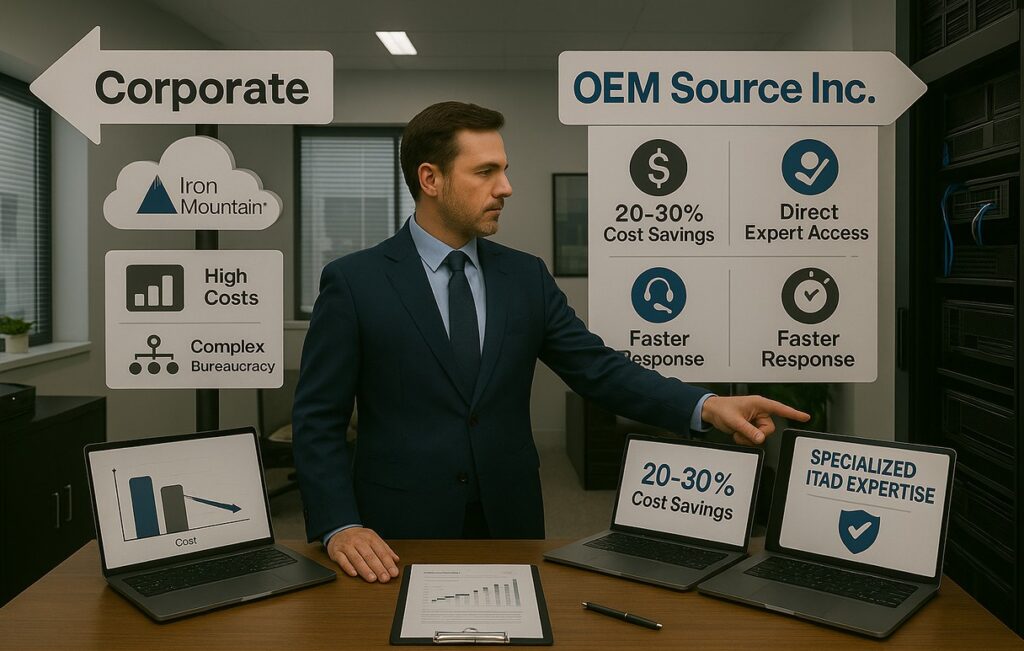Understanding IT Asset Recovery
Organizations today manage vast fleets of IT assets across multiple locations and teams. As devices age, become obsolete, or reach end-of-life, the challenge isn’t just disposal—it’s strategic recovery. IT asset recovery refers to reclaiming value from unused or outdated equipment, minimizing environmental impact, ensuring secure data destruction, and supporting circular economy goals.
By approaching IT asset recovery holistically, companies can drive operational efficiency, improve financial outcomes, and ensure compliance with environmental and data security regulations. It’s a strategy that transforms once-depreciated assets into opportunities for value recovery and sustainability.
With the IT asset disposition (ITAD) market forecasted to grow from $18.4 billion in 2023 to over $40.9 billion by 2032, developing a proactive recovery plan is now a competitive necessity.
Importance of IT Asset Recovery
What is IT Asset Recovery?
IT asset recovery is a structured process for managing surplus or obsolete equipment, from evaluation and secure data destruction to resale, redeployment, or responsible recycling. It focuses on maximizing value from equipment that would otherwise sit idle, aligning with both financial and sustainability goals. This process is critical in today’s technology-driven business world, where rapid hardware turnover is common.
How Does IT Asset Recovery Optimize Costs?
Strategic recovery directly translates into measurable financial and operational gains:
- Cost Savings: Companies see 25–30% savings over five years by implementing structured recovery programs.
- Operational Efficiencies: Centralized tracking, recovery, and re-marketing reduce downtime, storage burdens, and labor costs.
- Financial Returns: Asset remarketing and resale through secondary markets help recapture fair market value nd extend the useful life of hardware.
By turning idle or obsolete equipment into reusable capital, IT teams can partner with finance and procurement to drive greater return on investment (ROI) without compromising on performance or compliance.
Why is Compliance Crucial in IT Asset Recovery?
Data security and compliance risks escalate significantly at the point of device retirement. Regulations like GDPR, HIPAA, and NIST SP 800-88 require stringent data disposal protocols, and failure to comply can lead to severe financial penalties and reputational damage.
To meet these standards, recovery programs should include:
- Certified data destruction methods (such as data sanitization, secure erasure, or physical shredding).
- Chain-of-custody documentation.
- Detailed audit trails for internal and regulatory review.
Non-compliance doesn’t just carry financial risk—it can also cause reputational harm. Ensuring compliance through verified destruction methods protects sensitive corporate and customer data, reducing the risk of breaches and legal exposure. Additionally, detailed audit trails and documentation support internal audits and regulatory inspections.
IT Asset Recovery Process
An effective IT asset recovery strategy follows a structured and auditable lifecycle that aligns with IT and sustainability goals:
- Asset Inventory Assessment: Document asset condition and lifecycle status using IT asset management (ITAM) tools.
- Secure Decommissioning: Enable chain-of-custody tracking and certified data destruction to reduce compliance risk.
- Valuation and Sorting: Assess equipment for resale, redeployment, or recycling based on condition and market value.
- Remarketing: Sell viable IT equipment through secure resale channels to recapture residual value.
- Responsible Recycling: For non-functional assets, use R2- or ISO 14000-certified recycling processes to minimize environmental impact.
Each step plays a vital role in ensuring that no value is lost and that risks are mitigated. A well-designed process also integrates with corporate sustainability goals and IT lifecycle strategies.
Additionally, timely execution is critical to maximize equipment resale value before obsolescence further reduces its worth.
Innovative Tech-Driven Solutions
Data-Driven Asset Identification
AI-powered tracking tools and predictive analytics now help organizations identify underutilized or high-resale-value equipment in real-time, improving recovery timing and ROI.
By leveraging machine learning and big data, IT teams gain granular visibility into usage patterns, performance benchmarks, and lifecycle stages. This allows companies to flag devices that are idle, underperforming, or nearing end-of-life, enabling proactive recovery planning and better decision-making.
Digital Inventory Management Systems
Platforms like InvGate Asset Management provide centralized, real-time visibility into all IT assets, offering features such as automated alerts, digital audit trails, and remote inventory tracking.
This digitization helps:
- Reduce manual tracking errors.
- Enhance accountability.
- Support regulatory compliance.
Cloud-based systems also facilitate easier coordination across departments and locations, critical for hybrid or distributed teams managing assets across multiple locations.
AI-Powered Demand Matching
Machine learning algorithms can analyze global resale market trends to match recovered assets with in-demand buyers, accelerating time-to-sale and increasing returns.
These tools help organizations:
- Dynamically adjust resale strategies.
- Avoid unnecessary stockpiling.
- Time sales are based on predicted market value.
AI-driven resale insights ensure faster turnover and higher ROI by recommending optimal windows and channels for remarketing.
Blockchain for Transparent Transactions
Blockchain technology enables immutable, verifiable records of asset condition, ownership history, and certified data destruction, adding trust and traceability to the recovery process.
This transparency is especially important for audit-heavy industries like healthcare and finance, where every handoff must be documented. Blockchain enhances accountability and reduces fraud risk while improving stakeholder confidence in the integrity of asset recovery programs.
Overcoming Challenges in Data Security
Data security remains one of the most complex and high-risk elements of asset recovery. Without clear protocols, organizations risk breaches, penalties, and compliance failures.
Key strategies include:
- Data Erasure vs. Physical Destruction: While physical shredding guarantees irreversible destruction, software-based sanitization enables reuse and environmental savings.
- Certified Processes: Work with NAID AAA-certified providers who offer documented destruction protocols.
- Audit Trails: Maintain a complete chain-of-custody and provide certificates of data destruction for every retired asset.
A proactive data protection plan must include standardized protocols, employee training, and regular audits. These practices help reduce risk, support compliance, and protect organizational reputation during and after asset disposition.
Best Practices for Maximizing Returns
To ensure strong ROI on asset recovery, organizations should take a proactive, data-driven approach. Key best practices include:
- Start Early: Integrate recovery strategies during initial procurement planning to maximize lifecycle value.
- Centralized Management: Use ITAM platforms to maintain a real-time digital inventory.
- Segment Recovery Efforts: Classify assets by age, function, or brand to align strategies with current market demand.
- Preserve Device Integrity: Keeping devices intact boosts resale value, as confirmed by industry leaders.
- Document Everything: Track asset condition, movement, resale pricing, and destruction certificates to support compliance and analytics.
Automated reporting tools can enhance decommissioning forecasts, while internal service-level agreements (SLAs) help prevent delays and ensure timely processing. Collaboration between IT, procurement, and compliance teams is key to building a repeatable, value-driven recovery program.
Tips on Selecting the Right Asset Recovery Provider
Not all providers offer the same level of service. When selecting a recovery partner, evaluate based on their ability to support compliance, security, and sustainability:
- Certifications: Look for verifiable certifications such as R2 or NAID AAA.
- Global Reach: Ensure providers can manage international logistics, resale, and compliance.
- Data Security Capabilities: Confirm support for both certified physical and software-based data destruction.
- Customization: Choose partners who can tailor recovery plans to meet operational and regulatory needs.
You should also assess:
- Industry-specific experience.
- Integration with your existing asset management systems.
- Availability of SLAs and performance reporting.
- Client references and audit documentation.
Learn more about OEMSource’s secure lifecycle and IT asset recovery solutions.
Environmental Impact and Sustainability
According to Lenovo, 89% of organizations recycle less than 10% of their IT hardware, contributing to over 62 million tons of e-waste globally each year.
A sustainable recovery strategy focuses on:
- Reducing Electronic Waste: Extend equipment life through reuse or secure remarketing.
- Responsible Recycling: Dispose of components like lithium batteries, digital screens, and PCBs in compliance with environmental regulations.
- Advancing ESG Goals: Asset recovery aligns with sustainability reporting, investor confidence, and brand equity.
By prioritizing sustainable practices, companies not only maintain regulatory compliance, but they also appeal to eco-conscious investors and customers. Recovery programs that quantify carbon offsets and resource conservation provide measurable benefits for environmental, social, and governance (ESG) reporting.
Case Studies: Proven IT Asset Recovery Success
- Global Tech Corp: Recovered 80% of IT assets through a coordinated recovery and remarketing initiative, significantly improving value recovery and ESG performance metrics.
- Sycamore International: Demonstrated cost savings of over $500,000 annually by integrating automated decommissioning and blockchain transparency across asset disposal.
These examples illustrate the measurable value of structured recovery initiatives. From financial optimization to brand reinforcement, the benefits extend far beyond IT operations. As technology turnover accelerates, success stories like these will increasingly become benchmarks for recovery excellence.
Future Trends in IT Asset Recovery
Cloud-Based Collaboration Tools
Modern recovery platforms now integrate with digital workflow systems, enabling real-time collaboration between finance, IT, and compliance teams.
This integration ensures faster decision-making and minimizes bottlenecks. Cloud-based tools also provide stakeholders with dashboards that track real-time metrics such as recovery value, disposal timelines, and compliance gaps.
IoT Integration and RFID Tagging
Next-gen devices are embedded with QR codes and RFID tags, streamlining asset tracking and remote status updates.
These tools enable:
- Automated status updates.
- Geolocation for global operations.
- Accurate recovery forecasting.
By eliminating manual inputs, RFID and IoT improve both efficiency and data integrity in asset recovery workflows.
Circular IT Strategy Adoption
Enterprise recovery programs are now central to circular economy models, encouraging reuse, resale, and resource optimization.
Organizations are increasingly designing IT procurement strategies around recovery potential, selecting equipment based on ease of refurbishment or remarketing value. These strategies help companies reduce costs and meet sustainability targets simultaneously.
AI-Enhanced Risk Prediction
Predictive models flag at-risk IT equipment for early recovery or preventive maintenance, protecting uptime and minimizing data breach risks.
These tools can:
- Predict hardware failure timelines.
- Suggest optimal recovery schedules based on cost-benefit models.
- Simulate ROI for recovery vs. replacement.
By embedding AI insights into recovery planning, businesses reduce risk, improve uptime, and maximize lifecycle value.
Why IT Asset Recovery Should Be a Strategic Priority
From resale optimization to sustainability impact, IT asset recovery is now a core business function, not a post-disposal afterthought. Organizations that integrate recovery into lifecycle planning gain a competitive edge in cost savings, compliance, and ESG performance.
For tailored lifecycle management solutions, connect with the experts at OEMSource.
Frequently Asked Questions
What is the IT asset recovery process?
IT asset recovery involves identifying unused or end-of-life equipment, securely wiping data, evaluating resale potential, and determining whether to sell, reuse, or recycle each device. The process is structured and typically includes vendor collaboration for logistics, data destruction, and documentation.
What is the IT asset management approach?
IT asset management (ITAM) focuses on tracking, maintaining, and optimizing the lifecycle of IT assets from procurement to decommissioning, to ensure cost-effectiveness and compliance. It includes tools and policies that govern asset use, reporting, and strategic planning.
How are IT assets securely disposed of?
Proper IT asset disposal includes certified data destruction methods (physical or software-based), secure logistics, and recycling or resale. Providers should supply detailed documentation and certificates of destruction to support audits and regulatory compliance.
What are the key steps of asset recovery?
The core steps include asset tracking, condition assessment, data erasure, remarketing, and sustainable recycling. Each step must align with company policies, industry best practices, and regulatory requirements.
Why is IT asset recovery important for sustainability?
IT asset recovery supports circular economy principles by extending device lifespans, reducing e-waste, and conserving resources. When aligned with ESG strategies, recovery programs can also contribute to carbon offset tracking and sustainability reporting.





